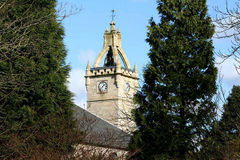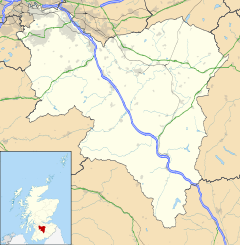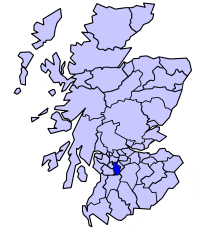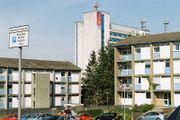East Kilbride
| East Kilbride | |
| Scottish Gaelic: Cille Bhrìghde an Ear | |
 East Kilbride parish church tower |
|
 East Kilbride
|
|
| Population | 73,796 [1] (2001 census) est. 73,320[2] (2006) |
|---|---|
| OS grid reference | |
| Council area | South Lanarkshire |
| Lieutenancy area | Lanarkshire |
| Country | Scotland |
| Sovereign state | United Kingdom |
| Post town | GLASGOW |
| Postcode district | G74-75 |
| Dialling code | 01355 & 0141 |
| Police | Strathclyde |
| Fire | Strathclyde |
| Ambulance | Scottish |
| EU Parliament | Scotland |
| UK Parliament | East Kilbride, Strathaven and Lesmahagow |
| Scottish Parliament | East Kilbride |
| List of places: UK • Scotland • | |
East Kilbride (Scottish Gaelic: Cille Bhrìghde an Ear) is a large suburban town in the South Lanarkshire council area, in the West Central Lowlands of Scotland. Designated as Scotland's first new town in 1947, it forms part of the Greater Glasgow conurbation. The area lies on high ground on the south side of the Cathkin Braes, about 8 miles (13 km) southeast of Glasgow city centre and close to the boundary with East Renfrewshire.
The town is enclosed by the White Cart River to the west and the Rotten Calder to the east, the latter flowing northwards to join the River Clyde near Cambuslang. This area was previously the site of the small and historic village of East Kilbride, prior to its post-war development. The modern settlement serves both as a dormitory town for the city of Glasgow and maintains its own commercial centre.
Contents |
History


The earliest evidence of habitation in the area dates back to ancient graves found near the Kype Water to the south of the district. Roman coins and footwear have also been found in the area.
East Kilbride takes its name from an Irish saint, St Bride (or Brigit) who founded a monastery for nuns and monks in Kildare, Ireland in the 6th century. Irish monks introduced her order to Scotland. Kil, from the Gaelic cill, means church or burial place.
The area of East Kilbride is home to a river valley which, apart from the Avon Gorge, is unique in the way it was formed. A river usually starts off narrow, fast-flowing, with steep cliffs, and in the hills. This is the youth of the river. Later once the river reaches flat land it begins to widen and meander and flow slower. This is the river's middle age. Calderglen is interesting in that it flows fast, has steep cliffs and is fairly narrow (youth stage) but also meanders. The Rotten Calder therefore has its river youth after its middle age, as the river source is on flatter land and is meandering and slow flowing.
Calderglen was in the past celebrated as a picturesque wooded valley. It was the home of a noble family known as the Maxwells of Calderwood who resided in Calderwood Castle. The remnants of Calderwood Castle were demolished in 1951.
The original parish church was located on the site of a pre-Christian sacred well, which is possibly the origin of the association with St. Brigit, since the well was dedicated to the Celtic goddess whose traditions the reverence of St. Brigit has continued. Over the centuries the church has been destroyed and rebuilt several times. As a result its current location has moved from its original site by about 50 m.
The presence of the oystercatcher bird in the coat of arms could arises because this bird was considered sacred to both St. Brigit and her pre-Christian antecedent or because it was part of the Lindsey family crest - which had local connections.
East Kilbride grew from a small village of around 900 inhabitants in 1930 to become eventually a large burgh. Behind this growth lay the rapid industrialisation of the nineteenth century which left much of the working population throughout Scotland's central belt from Glasgow to Edinburgh living in the housing stock built at the end of that century but accommodating far more people. The Great War postponed any better housing as did the Treaty of Versailles and the period of post war settlement it created. In turn this was followed by the Great Depression. After the Second World War, Glasgow, already suffering from chronic shortages of housing, had to deal with bomb damage from the war.
From this unlikely backdrop a new dawn emerged which would bring East Kilbride to its unlikely success. In 1946 the Greater Glasgow Regional Plan allocated sites where overspill satellite "new towns" could be constructed to help alleviate the housing shortage.[3] Glasgow would also undertake the development of its peripheral housing estates. East Kilbride was the first of five new towns in Scotland to be designated, in 1947, followed by Glenrothes (1948), Cumbernauld (1956), Livingston (1962) and Irvine (1964).[4]
The town has been subdivided into residential precincts, each with its own local shops, primary schools and community facilities. The housing precincts surround the shopping centre, which is bound by a ringroad. Industrial estates are concentrated at sites to the north, west and south, on the outskirts of the town.
Geography
East Kilbride forms part of the Greater Glasgow Conurbation.
Governance
| East Kilbride District 1975-96 | |
 |
From 1975 East Kilbride lent its name to a local government district in the Strathclyde region. In 1996 administrative functions were taken over by the South Lanarkshire unitary council. (See: Subdivisions of Scotland)
There is an East Kilbride constituency of the Scottish Parliament. Since the opening of the Scottish Parliament, the constituency has been represented by Andy Kerr MSP (Labour).
East Kilbride was formerly a constituency of the UK Parliament. In 2005 it was replaced by the constituency of East Kilbride, Strathaven and Lesmahagow. The seat has been held since 1987 by Adam Ingram.
Economy

The town centre is occupied by a large shopping centre comprising 6 linked malls, developed in phases. The malls are known by local residents as "The Centre".
The six malls are The Plaza (development started in 1972), Princes Mall (1984), Olympia (1988), Southgate (1989), Princes Square (1997) and Centre West (2003). The shopping centre has come under recent criticism for losing major retail chains in light of rising rental prices. This coupled with the Centre West expansion and decreasing shopper numbers has allowed swathes of properties within the centre to remain closed for months at a time, notably on the first floor of Centre West and the Plaza.
A £400m redevelopment of East Kilbride town centre has been given the go-ahead by South Lanarkshire Council. The plan would demolish some existing buildings to create a new civic centre, a state-of-the-art health centre, a library and shopping facilities.[5][6]

It would also see a "landmark" arts and culture complex with a 1,000-seat theatre, a 500-seat conference centre, a museum and a new town square.
Parking spaces in the town centre would increase from 3,000 to 8,700 spaces. The first stage of the plan was due to start in 2006, with completion of the major elements in 2012/2013, but the project has been indefinitely delayed. It is hoped the project, the various phases of which will require full planning permission, will create up to 3,000 temporary jobs over the 10-year construction programme and 2,000 permanent jobs.
The new civic and health facilities would be created at the site currently occupied by Plaza Tower, which would be demolished, with the theatre and arts facilities being created at the adjoining Olympia Centre.
The current civic centre and the adjoining Hunter Health Centre would be demolished to make way for the first phase of development, which would include a major food retail store.
There is to be a relocation of the hunter health center to a more central area where consumers can access it.
Transport
East Kilbride is connected to Glasgow city centre by road and rail. Three main roads connect East Kilbride with surrounding suburbs and the city, one being the A727 (formerly A726) leading west to Busby and on to Clarkston Toll. Another route being the A749 which runs north into Rutherglen. Recently, the addition of the 'southern orbital' road links the west of the town to the M77. This road has taken over the designation A726. East Kilbride bus station, at the shopping centre, was recently rebuilt and provides modern facilities. East Kilbride railway station is situated in the Village. Trains depart to Glasgow Central railway station every half hour, with a journey time of 27 minutes. The town is also served by Hairmyres railway station in Hairmyres.
East Kilbride's primary bus operator is First Glasgow which provides regular services to the city centre, Busby, Clarkston, Castlemilk, Cambuslang, Rutherglen, Hamilton, Motherwell and the surrounding area. Stagecoach West Scotland provide a half-hourly to hourly service to Ayr, McKindless used to provide an hourly service to Wishaw, Carluke and Lanark, and smaller bus operators provide links to other destinations such as Strathaven and Newarthill. Arriva have recently started a new hourly 600 service to the Airport via: Busby, Clarkston, Giffnock, Thornliebank, Silverburn Centre, Hurlet, and Paisley.
Similar to other New Towns, the road network within the town is populated by many roundabouts; Glaswegians jokingly refer to East Kilbride as "roundabout city". The reference is in fact "Polo mint City" after the round, mint sweet.[7]
Famous people living in EK
Christopher Ballantyne
Dylan Buchannon
Farser Lang
and the famous Gay Pride supporter Ryan Carey
Cycling
East Kilbride is a good place for cycling with many of the busy roundabouts having underpasses for pedestrians and cyclists. On 19 June 2009, National Cycling Route 756 was opened and connects East Kilbride and Rutherglen with the Glasgow City Boundary.
Landmarks

Dollan Baths
One of the most significant buildings of an earlier phase of development was Dollan Baths leisure complex (opened 1968) which has category A listed status. The Dollan Baths are the subject of a local urban myth, which told that the pool was built 5 cm short of Olympic size. In actual fact, the pool was built as 55 yards long, but is only six lanes wide, rather than the Olympic standard of 50m and ten lanes wide.
Hunter House Museum
Contains exhibits relating to medical pioneers, William and John Hunter, who were born in the area.
St. Brides's Church
By architects Gillespie, Kidd and Coia, 1957-1964.
Parks and sports
East Kilbride Thistle is the town's main football club. (It is the largest town in Scotland without a senior football team, however a new club, East Kilbride has been formed and could be included in the Scottish Football League in roughly 5 years time.)
East Kilbride RFC, are based at Calderglen Country Park.
East Kilbride Lawn Tennis Club is one of the oldest tennis club in Scotland.
East Kilbride Pirates play in the British American Football League.
EK82 Handball Club Founded in 1972, they train at the John Wright Sports Centre and the Alistair McCoist Complex. They play in the Scottish National League.
Athletics in the town is covered by 3 athletics clubs. Whitemoss, East Kilbride and Calderglen. Both Whitemoss and East Kilbride Athletic Club are based at the John Wright Sports centre.
Twin town
 Ballerup, Denmark
Ballerup, Denmark
Notable people
- George Orwell (pen name of Eric Blair), entered Hairmyres Hospital, which was on the edge of the then village of East Kilbride, in the week before Christmas 1947
- William and John Hunter, medical pioneers, were born at Long Calderwood within the present-day area of East Kilbride
- Lorraine Kelly, television presenter for GMTV was born in the town
- Iain Harvie, guitarist with Scottish rock band Del Amitri, was an East Kilbride resident. His late father, John Harvie, was the popular headmaster of Claremont High School in East Kilbride in the 1980s and early 1990s.
- Actor John Hannah of Rebus and Four Weddings and a Funeral fame was a resident of East Kilbride, residing in the Murray area
- Adair Turner, former Director-General of the Confederation of British Industry (CBI), lived there during his youth
- Liam Fox, Conservative MP for Woodspring and the current Secretary of State for Defence, was born and raised in the town
- Scottish rock band The Jesus and Mary Chain were formed in the town
- Muriel Gray , journalist and broadcaster, was born in the town
- Roddy Frame, frontman of Scottish indie band Aztec Camera, was born in the town
- David Scott, singer-songwriter of The Pearlfishers has many produced notable records from a recording studio in the East Kilbride Arts Centre.
- Ally McCoist, Scottish former professional footballer, and now assistant manager at Glasgow Rangers was brought up in the town
- Kirsty Young, Scottish television and radio presenter and actress was born in the town
- Ross Montgomery, Scottish darts player and resident of East Kilbride
- Marc Warren, Scottish professional golfer, lived and grew up in town, playing golf at East Kilbride Golf Club
References
- ↑ "Comparative Population Profile: East Kilbride Locality". Scotland's Census Results Online. 2001-04-29. http://www.scrol.gov.uk/scrol/browser/profile.jsp?profile=Population&mainArea=east+kilbride&mainLevel=Locality. Retrieved 2008-09-02.
- ↑ http://www.gro-scotland.gov.uk/statistics/publications-and-data
- ↑ http://www.theglasgowstory.com/story.php?id=TGSFG10
- ↑ Cowling, D. (1997). An Essay for Today: the Scottish New Towns 1947-1997. Edinburgh: Rutland Press.
- ↑ http://www.eastkilbride.org.uk/community/redeveloping-east-kilbridede.htm East Kilbride Town Centre redevelopment
- ↑ http://news.bbc.co.uk/1/hi/scotland/4870462.stm BBC News (2006) New town could get £400m facelift
- ↑ http://news.bbc.co.uk/1/hi/scotland/glasgow_and_west/7334457.stm BBC News (2008) Roundabouts in East Kilbride
External links
- Interactive picture guide of East Kilbride
- East Kilbride's Shopping Centre
- Business and Community
- Community and Local Events
- East Kilbride Pirates American Football team
- Dybamica Drum Corps, East Kilbride
Further interest
New towns
- "The Disappointing New Towns of Great Britain
- "New Towns: Can They Be Given New Life?"
- "Building Towns for the future"
|
|||||||||||